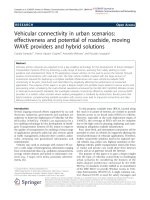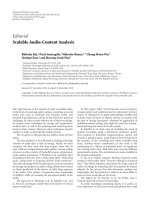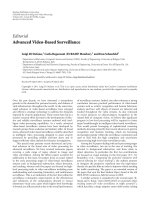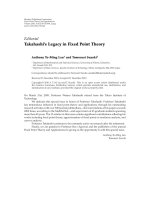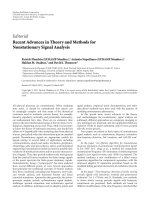Báo cáo hóa học: " Editorial Advances in Electrocardiogram Signal Processing and Analysis" pptx
Bạn đang xem bản rút gọn của tài liệu. Xem và tải ngay bản đầy đủ của tài liệu tại đây (1.34 MB, 5 trang )
Hindawi Publishing Corporation
EURASIP Journal on Advances in Signal Processing
Volume 2007, Article ID 69169, 5 pages
doi:10.1155/2007/69169
Editorial
Advances in Electrocardiogram Signal Processing and Analysis
William Sandham,
1
David Hamilton,
2
Pablo Laguna,
3
and Maurice Cohen
4
1
Scotsig, Glasgow G12 9PF, UK
2
Ateeda Limited, Edinburgh EH3 8EG, UK
3
Department of Electronic Engineering and Communications, Zaragoza University, 50018 Zaragoza, Spain
4
UCSF Fresno Center for Medical Education, School of Medicine, University of California, San Francisco, Fresno,
CA 93701-2302, USA
Received 3 April 2007; Accepted 3 April 2007
Copyright © 2007 William Sandham et al. This is an open access article distributed under the Creative Commons Attribution
License, which permits unrestricted use, distribution, and reproduction in any medium, provided the original work is properly
cited.
Since itsinvention by the Dutchman Willem Einthoven
(1860–1927) during the late 19th and early 20th centuries,
when it was little more than a scientific curiosity, the elec-
trocardiogram (ECG) has developed into one of the most
important and widely used quantitative diagnostic tools in
medicine. It is essential for the identification of disorders of
the cardiac rhythm, extremely useful for the diagnosis and
management of heart abnormalities such as myocardial in-
farction (heart attack), and it offers helpful clues to the pres-
ence of generalized disorders that affect the rest of the body,
such as electrolyte distur bances and drug intoxication.
Recording and analysis of the ECG now involve a con-
siderable amount of signal processing; for S/N enhance-
ment, beat detection and delineation, automated classifica-
tion, compression, hidden information extraction, and dy-
namic modeling. These involve a whole variety of innovative
signal processing methods, including adaptive techniques,
time-frequency and time-scale procedures, artificial neural
networks and fuzzy logic, higher-order statistics and nonlin-
ear schemes, fractals, hierarchical trees, Bayesian approaches,
and parametric models, amongst others.
This special issue reviews the current status of ECG sig-
nal processing and analysis, with particular regard to recent
innovations. It reports major achievements by academic and
commercial research institutions and individuals, and pro-
vides an insight into future developments within this exciting
and challenging area. It is perhaps appropriate that a special
issue of EURASIP JASP be devoted to ECG signal processing
and analysis, since the ECG is now celebrating its centennial
(DijkandVanLoon[1]).
The first pap er, “Multiadaptive bionic wavelet transform:
application to ECG denoising and baseline wandering reduc-
tion,” by O. Sayadi and M. B. Shamsollahi, describes a new
modified wavelet transfor m that can be used to remove a
wide range of noise from an ECG signal. Signal decompo-
sition is obtained using the bionic wavelet transform, adap-
tively determining both the center frequency of each scale,
together with the T-function. A threshold rule is then ap-
plied. The method was tested with both real and simulated
ECG signals. Results demonstrate a significantly better noise
reduction compared with standard wavelet transform tech-
niques; the average signal-to-noise ratio improved by a factor
of 1.82 (best case). The method also produced better results
in relation to baseline wandering calculations for both DC
components and shifts.
The second paper, “Hardware implementation of a mod-
ified delay-coordinate mapping-based QRS complex detec-
tion algorithm,” by Matej Cvikl et al., describes a QRS de-
tection algorithm specifically designed for hardware imple-
mentation. It uses a modified delay-coordinate mapping-
based algorithm, prefiltering, and better threshold calcu-
lation methods to improve the original two-dimensional
phase-space portrait. Results on the MIT-BIH arrhythmia
and long-term ST databases indicate excellent sensitivity and
predictivity.
The next two papers cover the important topic of ECG
compression. “A simple method for guaranteeing ECG qual-
ity in real-time wavelet lossy coding,” by A. Alesanco and
J. Garc
´
ıa, proposes a new distortion index wavelet-weighted
PRD (WWPRD), which aims to provide a more realistic de-
scription of the clinical distortion of the compressed sig-
nal. The method applies the wavelet transform and the
subsequent coding uses the set partitioning in hierarchi-
cal trees (SPIHT) algorithm. By thresholding the WW-
PRD in the wavelet transform domain, a very precise re-
construction error was achieved, allowing clinically useful
2 EURASIP Journal on Advances in Signal Processing
reconstructed signals to be obtained. Again, results from two
ECG databases indicate that the method can accurately con-
trol the quality in terms of mean value with a low standard
deviation. Some discussion of the impact of baseline wander
and noise is included, along with a description of the clini-
cal validation sought for these results. The second paper in
this category, “Lossless compression schemes for ECG sig-
nals using neural network predictors,” by K. Ramakrishnan
and E. Chikkannan, presents lossless compression schemes
for ECG signals based on neural network predictors and en-
tropy encoders. Decorrelation is achieved by nonlinear pre-
diction in the first stage and encoding of the residues is done
by using lossless entropy encoders in the second stage. Dif-
ferent types of lossless encoders, such as Huffman, arith-
metic, and runlength encoders are used. The performances of
the proposed neural network predictor-based compression
schemes are evaluated using standard distortion and com-
pression efficiency measures. Selected records from the MIT-
BIH arrhythmia database are used for performance evalua-
tion. The proposed compression schemes are compared with
linear predictor-based compression schemes and it is shown
that about 11% improvement in compression efficiency can
be achieved for neural network predictor-based schemes with
the same quality and similar setup. They are also compared
with other known ECG compression methods and the exper-
imental results show that superior performances in terms of
the distortion parameters of the reconstructed signals can be
achieved with the proposed schemes.
Segmentation and delineation is the topic covered by
the fifth paper, “Combining wavelet transform and hidden
Markov models for ECG segmentation,” by R. V. Andre
˜
ao
and J. Boudy. This work aims at providing new insights
into the ECG segmentation problem using wavelets. The
wavelet transform has been originally combined with a hid-
den Markov model (HMM) framework in order to carry out
beat segmentation and classification. A group of five contin-
uous wavelet functions commonly used in ECG analysis has
been implemented and compared using the same framework.
All experiments were realized on the QT database, which is
composed of a representative number of ambulatory record-
ings of several indiv iduals and is supplied with manual labels
made by a physician. A consistent set of experiments was per-
formed, and comparable results with other published works
were obtained in terms of beat delineation and premature
ventricular beat (PVC) detection, independently of the type
of wavelet. Optimum per formance was achieved by combin-
ing two wavelet functions in the delineation stage.
The next two papers address the topic of ECG modeling.
In the first paper, “Modeling of electrocardiogram signals us-
ing predefined signature and envelope vector sets,” by Hakan
G
¨
urkan et al., a method for modeling ECG signals is pro-
posed based on a predefined signature and envelope vector
set (PSEVS). The ECG signal is reconstructed by multiplying
three parameters: predefined signature vector (PSV
R
), prede-
fined vector envelope (PEV
K
), and frame-scaling coefficient
(FCS). The first two measures are labeled and stored to de-
scribe the signal in the reconstruction process. An ECG signal
frame is modeled as members of the sets labeled R and K and
the frame-scaling coefficient in the least-mean-square sense.
The method is assessed using the percentage of root-mean-
square difference and also using visual inspection measures.
Results show that the method provides significant data com-
pressions ratios and low-level root-mean-square differences
while preserving diagnostic information, thus significantly
reducing the bandwidth required for telediagnosis. The sec-
ond paper in this category, “multi-channel ECG and noise
modeling: application to maternal and fetal ECG signals,”
by Reza Sameni et al., presents a three-dimensional dynamic
model of the electrical activity of the heart. It is based on
the single dipole model of the heart and is later related to
the body surface potentials through a linear model which ac-
counts for the temporal movements and rotations of the car-
diac dipole, together with a realistic ECG noise model. The
proposed model is also generalized to maternal and fetal ECG
mixtures recorded from the abdomen of pregnant women
in single and multiple pregnancies. The applicability of the
model for the evaluation of signal processing algorithms is
illustrated using independent component analysis. Consid-
ering the difficulties and limitations of recording long-term
ECG data, especially from pregnant women, the model de-
scribed in this paper may serve as an effective means of simu-
lation and analysis of a wide range of ECGs, including adults
and fetuses.
The next two papers address a very useful DSP technique
for ECG signals—principal component analysis (PCA). The
first paper, “Principal component analysis in ECG signal pro-
cessing,” by Francisco Castells et al., provides a comprehen-
sive review of the topic, and covers the fundamentals of PCA
and its relationship to the Karhunen-Lo
`
eve transform. As-
pects on PCA related to data with temporal and spatial cor-
relations are considered, together with adaptive estimation
of principal components. Several ECG applications are re-
viewed, particularly where PCA techniques have been suc-
cessfully employed. These include data compression, ST-T
segment analysis for the detection of myocardial ischemia
and abnormalities in ventricular repolarization, extraction of
atrial fibrillatory waves for detailed characterization of atrial
fibrillation, and analysis of body surface potential maps. The
second paper, “A principal component regression approach
for estimating ventricular repolarization dur ation variabil-
ity,” by Mika Tarvainen et al., introduces the idea of com-
puting the ventricular repolarization duration (VRD) vari-
ability, not from some fiducial point (typically R-wave to T-
peak or T-end) which has a large delineation uncertainty, but
from a PCA decomposition parameter. PCA decomposition
is applied to T-wave segments synchronized with the R-wave.
The first eigenvalue is considered to be representative of the
mean T-wave shape and the second eigenvalue is of the T -
variability. Robustness is presented as the major advantage of
the method, and good correlation results with classical vari-
ability measures are demonstrated. Results are presented on
a stress test application.
The final selection of papers deal with the analysis of
the ECG for detecting specific medical conditions. The first
paper, “Diurnal changes of heart rate and sympathovagal
activity for temporal patterns of transient ischemic episodes
William Sandham et al. 3
in 24-hour electrocardiograms,” by A. Smrdel and F. Jager,
presents a method for analyzing temporal patterns of tran-
sient ST segment changes compatible with ischemia, with
the hypothesis that different patterns are a result of differ-
ent physiological mechanisms. The study is based on 24-hour
records that were divided into morning, day, and night in-
tervals. Three temporal patterns are considered: salvo, pe-
riodic, and sporadic. B oth time and frequency measures of
heart rate in the neighborhood of ischemic events were an-
alyzed using an adaptive autoregressive method with a re-
cursive least-square algorithm, for consistent spectral track-
ing of heart rate, to study frequency-domain sympathovagal
behavior during ischemia. Results indicate two distinct
populations that differ according to mechanism and tempo-
ral patterns of ischemia. In the second paper, “Real-time car-
diac arrhythmia detection using WOLA filterbank analysis of
EGM signals,” by Hamid Sheikhzadeh et al., novel methods
of cardiac rhythm detection are proposed that are based on
time-frequency analysis by a weighted overlap-add (WOLA)
oversampled filterbank. Cardiac signals are obtained from
intracardiac electrograms and are decomposed into the time-
frequency domain and are analyzed by parallel peak detectors
in selected frequency subbands. The coherence (synchrony)
of the subband peaks is analyzed and employed to detect
an optimal peak sequence representing the beat locations.
By further analysis of the synchrony of the subband beats
and the periodicity and regularity of the optimal beat, vari-
ous possible cardiac events (including fibrillation, flutter, and
tachycardia) are detected. Evaluation results show very good
performance in clean and noisy conditions, and robustness
to far-field R-wave interference. The third paper, “Corrected
integral shape averaging applied to obstructive sleep apnea
detection from the electrocardiogram,” by S. Boudaoud et
al., presents a technique called corrected integral shape av-
eraging (CISA) for quantifying shape and shape differences
in a set of signals. The method can be used to account for
signal differenc es which are purely due to affine time warp-
ing (jitter and dilation/compression), and hence provides ac-
cess to intrinsic shape fluctuations. CISA can also be used
to define a distance between shapes which have useful math-
ematical properties, and the procedure also allows joint es-
timation of the affine time parameters. Numerical simula-
tions are presented to support the algorithm. CISA provides
a well-defined shape distance, which can be used in shape
clustering applications based on distance measures such as
k-means. An application is presented in which CISA shape
clustering is applied to P-waves extracted from the ECGs
of subjects suffering from sleep apnea. The resulting shape
clustering distinguishes ECG segments recorded during ap-
nea from those recorded during normal breathing with a
sensitivity of 81% and specificity of 84%. The fourth paper,
“Time-frequency analysis of heart rate variability for neona-
tal seizure detection,” by M. B. Malarvili et al., proposes a
technique for detecting epileptic seizures from the ECG in
the human neonate. The suitability of heart rate variabil-
ity (HRV) as a tool for seizure detection in newborns is ex-
plored. Features of HRV in different frequency bands have
been obtained by means of quadratic time-frequency dis-
tributions (TFDs). The first conditional moment of HRV,
which is the mean/central frequency in the LF band (0.03–
0.07 Hz) and the variance in the HF band (0.15–0.6 Hz)
is shown to have the ability to discriminate the newborn
seizure from nonseizure. In the final paper in this category,
“Clustering and symbolic analysis of cardiovascular signals:
discovery and visualization of medically relevant patterns in
long-term data with limited prior knowledge,” by Zeeshan
Syed et al., automated techniques are presented for analyz-
ing large amounts of cardiovascular data without the require-
ment of aprioriknowledge of disease states. The process be-
gins by transforming continuous waveform signals into sym-
bolic strings derived from the data. Morphological features
are used to partition heartbeats into clusters by maximiz-
ing the dynamic time-warped sequence-aligned separation
of clusters. Each cluster is then assigned a symbol, and the
original signal is replaced by the corresponding sequence of
symbols, thus greatly reducing the amount of data. The se-
quence analysis is used to discover rhythms, transient pat-
terns, abnormal changes in entropy, and clinically significant
relationships among multiple streams of physiological data.
The method was tested on cardiologist-annotated ECG data
for 48 patients. The labeling process for heartbeats showed
98.6% agreement with the assessment of the cardiologist,
and often provided finer-grain distinctions. Using no prior
knowledge,caseswithanumberofdifferent arrhythmias
were successfully detected.
ACKNOWLEDGMENTS
We are extremely grateful to all the reviewers w ho took time
and consideration to assess the submitted manuscripts. Their
diligence has contributed greatly to ensuring that final pa-
pers have conformed to the high standards expected in this
publication. Finally, we wish to dedicate this special issue to
the memory of Professor Arnon Cohen, Ben Gurion Univer-
sity, Israel, who passed away in 2004, and who was one of
the major pioneers in in ECG signal processing and analysis.
A brief biography of Professor Cohen appears below. We are
indebted to his family, friends, and professional colleagues
for providing this information.
Professor Arnon Cohen (1938–2005)
ArnonCohenwasborninHaifa,Is-
rael, in 1938. He received the B.S.
and M.S. degrees in electrical engi-
neering from the Technion – Israel
Institute of Technology, in 1964 and
1966, respectively, and the Ph.D. de-
gree in electrical and biomedical
engineering, from Carnegie-Mellon
University in 1970. From 1970 to
1972, he was an Assistant Professor of electrical and biomed-
ical engineering in the University of Connecticut. In 1972,
he returned with his family to Israel, and joined the newly
formed Department of Electrical and Computer Engineer-
ing, and the Biomedical Engineering Program, in the Ben
Gurion University of the Negev, at Beer Sheva, Israel. The
4 EURASIP Journal on Advances in Signal Processing
Electrical Engineering Department at Ben Gurion University
was first established in the late sixties as an extension of the
Technion – Israel Institute of Technology, and Technion pro-
fessors used to fly from Haifa to Beer Sheva, perform their
teaching duties, and fly back home. Beer Sheva was relatively
remote from the center of Israel, and joining the new univer-
sity in the Negev was considered then to be a pioneering ad-
venture. In 1973, Arnon was appointed as an Associate Pro-
fessor.
From 1974 to 1976 and from 1978 to 1986, Arnon was
Chairman of the University’s Biomedical Engineering Pro-
gram, and from 1976 to 1977, he was a Visiting Professor at
the Electrical Engineering Department, Colorado State Uni-
versity. In 1986 he was promoted to Full Professor of elec-
trical, computer and biomedical engineering . During 1989-
1990, he spent a year in Cape Town, South Africa, as a Visit-
ing Scientist at the South African Medical Research Coun-
cil (MRC), the Foundation of Research and Development
(FRD), and the University of Cape Town. In addition to his
academic duties, Arnon served as a consultant to several Is-
raeli hi-tech companies (1982–2000), and held the position
of CTO at Sesame Systems (1985-1986) and the DSP Group
(1997–2000).
Arnon was a Senior Member of IEEE, and a Mem-
ber of the Israeli Society for Medical and Biomedical En-
gineering (IFMBE affiliated). He was the Associate Editor
of the IEEE Transactions on Biomedical Engineering (1996–
2000), Guest Editor of the IEEE-EMBS Magazine (Special Is-
sue on Biomedical Signal Databases), and Chairman of the
IEEE Biomedical Engineering Society, Israeli Chapter (1996–
2001).
Arnon’s research interests covered many areas in sig-
nal processing and recognition, mainly in biomedical and
speech applications. Ten Ph.D. students and more than thirty
M.S. students completed their degrees under his supervision.
Many of them have now taken senior research and develop-
ment positions in Israeli hi-tech companies, ensuring that his
legacy is kept alive.
His research in acoustic signal processing as a medical
tool was creative and original, and included extensive col-
laboration with medical doctors at the Soroka Medical Cen-
ter in Beer Sheva. He made some significant contributions
to the analysis and compression of ECG signals, and to sev-
eral other applications involving biomedical signal process-
ing (EEG, EMG, breathing and stridor sounds, lung sounds
during incubation, infant’s cry, snoring signals, and more).
Arnon collaborated with researchers in Ben Gurion Uni-
versity as well as in other universities on language-related
issues and audio analysis and recognition, and was an
inspirational leader w ithin these groups. He focused on is-
sues of speech (phoneme, vowel, and word) recognition,
speaker recognition, and speaker verification. He was a well-
respected author and published more than 100 research pa-
pers in refereed international journals and conference pro-
ceedings. He also wrote the seminal book Biomedical Signal
Processing, (CRC Press, Boca Raton, Fla, 1986).
Arnon was diagnosed with Leukemia in 1999, not long
after his beloved wife Yama (Miriam) passed away. He offi-
cially retired in 2003, but continued working with his gradu-
ate students until his final days. He passed away in February
2005 at the age of 67, after a shar p downturn in his condition.
However, he is sur vived by three sons (Boaz, Gilad, and Na-
dav), all electrical engineers, a daughter-in-law (Michal), and
three grandchildren (Shira, Jonathan, and Itay), to whom he
showed great love and affection. A more recent addition to
the family, granddaughter (Hagar) will only know her grand-
father through tales and anecdotes, of which there are many.
In his spare time, Arnon enjoyed traveling, hiking, wild-
flower photography, and listening to classical music and
opera. His death is a sad loss to everyone who were fortu-
nate enough to know him, and he will be greatly missed by
his family, friends, students, and colleagues.
William Sandham
David Hamilton
Pablo Laguna
Maurice Cohen
REFERENCES
[1] J. Dijk and B. Van Loon, “The electrocardiogram centen-
nial: Willem Einthoven (1860–1927),” Proceedings of the IEEE,
vol. 94, no. 12, pp. 2182–2185, 2006.
William Sandham is Managing Director of
Scotsig, an independent signal and image
processing research, consultancy, and train-
ing company based in Glasgow, and he is
a Visiting Professor in the Department of
Bioengineering, University of Strathclyde.
He received the B.S. and Ph.D. degrees
from the Universities of Glasgow (1974) and
Birmingham (1981), worked as a Medical
Physicist from 1974 to 1976, and was a Geo-
physicist with the British National Oil Corporation and Britoil,
from 1980 to 1986. From 1986 to 2003, he was a Lecturer/Senior
Lecturer/Reader at the University of Strathclyde, Glasgow. He has
published over 150 technical papers and 5 books, he is a Senior
Member of the IEEE, and Member of the EAGE and SEG. He
has served on a number of IEEE and other editorial boards, and
the conference organizing committees of ICASSP (1989), TA-91
(1991), and EUSIPCO (1994). He was Chairman of IEEE and
EAGE International Workshops in Glasgow (1991) and Geneva
(1997), the IET MEDSIP Conference (2006), and is Chairman of
the IET Symposium on Technology in Diabetes Care (2007). He
has been an Invited Lecturer at a number of leading research insti-
tutions across the UK, Europe, and South America, and has acted as
a Consultant for major companies in Europe and North America.
David Hamilton is a Ph.D. MIET Char-
tered Electrical Engineer. Since February
2007, he has been Chief Executive Officer
for Ateeda Limited, a semiconductor soft-
ware company, he has worked as Senior
Lecturer in the Department of Electronic
and Electrical Engineering at the University
of Strathclyde since January 1991. He has
wide interests in a variety of fields. These
range from biomedical to seismic surveying,
William Sandham et al. 5
often with a strong signal processing theme. Biomedical interests
include ECGs (acquisition hardware through the signal process-
ing applied to ECGs) through EEGs (brain-computer interface)
and ultrasound diagnostic techniques. He has also been involved
in evoked potential research (depth of anaesthesia) and blood glu-
cose prediction (diabetes therapy). He completed his Ph.D. degree,
“Novel strateg ies for enhancing artificial neural network solutions,”
in 1996 while lecturing at Strathclyde included work on ECG com-
pression. He has carried out commercial research programs in col-
laboration with many multinational corporations. Prior to this, he
spent 8 years in industry in various companies from startups to
multinationals in positions ranging from Graduate Design Engi-
neer to Design Manager. A First Degree in Electronics and Physics
from the University of Edinburgh completed in 1983 provided the
basis for the eclectic research interests he has now.
Pablo Laguna was born in Jaca (Huesca),
Spain, in 1962. He received the Physics de-
gree (M.S.) and the Doctor in Physic Sci-
ence degree (Ph.D.) from the Science Fac-
ulty at the University of Zaragoza, Spain,
in 1985 and 1990, respectively. The Ph.D.
thesis was developed at the Biomedical
Engineering Division of the Institute of
Cybernetics (UPC-CSIC) under the direc-
tion of Pere Caminal. He is Full Professor
of signal processing and communications in the Department of
Electrical Engineering at the Engineering School, and a Researcher
at the Aragon Institute for Engineering Research (I3A), both at
University of Zaragoza, Spain. From 1992 to 2005, he was Asso-
ciate professor at the same university, and from 1987 to 1992 he
worked as Assistant Professor of automatic control in the Depart-
ment of Control Engineering at the Politecnic University of Cat-
alonia (UPC), Spain, and as a Researcher at the Biomedical Engi-
neering Division of the Institute of Cybernetics (UPC-CSIC). His
professional research interests are in signal processing, in particular
applied to biomedical applications. He is, together with L. S
¨
ornmo,
the author of Bioelectrical Signal Processing in Cardiac and Neuro-
logical Applications (Elsevir, 2005).
Maurice Cohen is Professor of radiology at
University of California, San Francisco, and
also Professor in the Graduate Groups in
biological and medical informatics and the
Joint Graduate Group in bioengineering at
UCSF and UC Berkeley. He has over 240
publications in the areas of applied math-
ematics, artificial intelligence in medicine,
chaotic modeling, signal analysis, complex
systems, neural networks, and image pro-
cessing. He has received numerous honors, including the Fac-
ulty Research Award from UCSF and Outstanding Professor from
CSUF. He was named Renaissance Scholar by the National Honor
Society of Phi Kappa Phi. He is a Fellow of the American Institute
for Medical and Biological Engineering for his pioneering work in
cardiology for which he also was awarded a prize from the Amer-
ican Medical Informatics Association. He solved two problems in
mathematics and chaos theory that were believed to be insoluble. In
addition, he is an internationally recognized artist and has shown
his painting in San Francisco, Carmel, NY, and Paris, including the
2006 Salon of the Soci
´
ete Nationale des Beaux Arts in the Caroussel
du Louvre.


